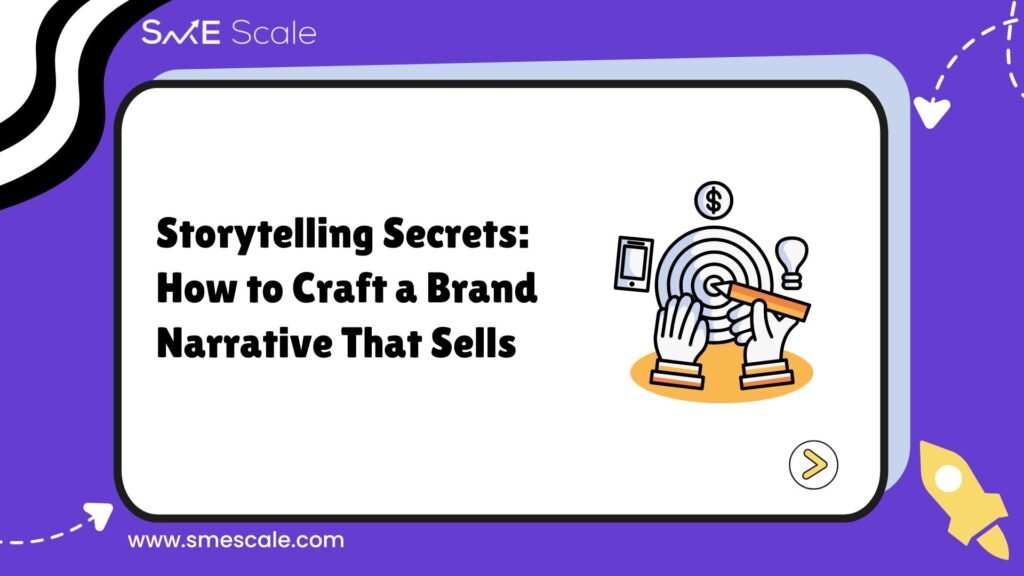
Why Every SME Needs a Compelling Story to Unlock Scalable Growth
In an increasingly noisy market, small and medium-sized enterprises (SMEs) can’t rely on product specs, discount pricing, or even clever ads alone. Today’s customers crave connection. They want to understand not just what you do, but why you do it.
At SME Scale, we’ve helped countless businesses unlock growth through scalable sales systems—but one of the most underutilized tools we consistently see is brand storytelling. When done right, a compelling narrative doesn’t just attract attention—it drives conversions, loyalty, and long-term business growth.
In this article, you’ll learn the psychology behind why storytelling works, see a real-life case study of brand narrative done right, and get actionable strategies to craft a brand story that sells.
Why Storytelling Works in Marketing
Humans are hardwired for stories. From ancient cave drawings to viral TikToks, storytelling is how we make sense of the world. And when you apply this to your business, you’re not just selling a product—you’re creating a shared emotional experience.
Here’s the psychology behind why stories sell:
Mirror Neurons: When we hear a story, our brain simulates the experience. This makes your brand more relatable.
Emotional Memory: People forget facts but remember how you made them feel. Stories create emotional anchors that last.
Cognitive Fluency: A clear, structured narrative is easier for the brain to process than scattered facts or data.
Identity Alignment: Customers buy into brands that reflect their values, aspirations, or struggles.
In other words: stories humanize your brand, build trust, and increase perceived value—a perfect combination when paired with SME Scale’s systemized sales frameworks.
Case Study: How a Local Coffee Brand Brewed Its Way to National Recognition
The Business:
Mountain Brew Co., a small-batch coffee roaster in Wales, was struggling to differentiate itself in a saturated local market. Their beans were excellent, but their growth had flatlined.
The Challenge:
They were marketing like everyone else—highlighting bean origin, freshness, and pricing. But customers couldn’t connect with a reason to choose them over a competitor.
The Solution: A Compelling Brand Narrative
With guidance rooted in the SME Scale philosophy, the company restructured its messaging around a powerful story:
“Mountain Brew was born in a camper van, on a rainy weekend hike in Snowdonia, when two friends decided that coffee should be more than a morning fix—it should be a ritual that grounds you in nature.”
This story appeared on every touchpoint—from packaging to website to social media.
Step 1: Building Emotional Resonance
Their brand narrative spoke to outdoorsy, mindful consumers who cared about experiences over convenience. This created an immediate emotional hook.
Step 2: Integrating Identity Psychology
They used storytelling to align the brand with the identity of their audience: conscious consumers, nature lovers, and adventurous spirits.
“When you brew Mountain Brew, you’re not just drinking coffee. You’re reconnecting with your wild.”
Step 3: Creating Consistent Narrative Arcs
Each product line came with a story:
“The Hiker’s Blend” for pre-summit energy.
“Campfire Roast” for slow moments in the woods.
“Trailhead Decaf” for unwinding after a climb.
Step 4: Leveraging Story-Based Marketing
Instead of traditional ads, they created short videos showing customers making coffee on trailheads, by rivers, and in camper vans—with the founders narrating their journey. This drove massive engagement.
The Results:
Online sales increased by 123% in six months
Brand recall shot up, with customers tagging them on Instagram using their own hiking stories
Wholesale interest grew, with outdoor retailers asking to stock the brand
How SMEs Can Craft a Brand Story That Sells
Whether you’re selling software, services, or coffee, your story can become your strongest differentiator. Here’s how to create one that connects and converts:
✅ 1. Know Your “Why”
Why did your company start? What problem were you trying to solve? What belief drives you? This emotional origin is often the heart of your story.
✅ 2. Identify the Hero—Hint: It’s Not You
Your customer is the hero. Your business is the guide. Frame your story around helping them overcome their challenges.
✅ 3. Use Conflict and Resolution
Every great story includes struggle. Don’t be afraid to show the obstacles you faced—or the ones your customers face—and how you help overcome them.
✅ 4. Make It Personal and Visual
Use real people. Real places. Real emotion. Avoid corporate jargon and abstract language. Show the humans behind the brand.
✅ 5. Repeat It Everywhere
A strong brand story should be woven into your website, sales pitch, social content, packaging, and even your pricing strategy.
Bringing It All Together: Stories + Systems = Scale
At SME Scale, we believe that sustainable growth isn’t about working harder—it’s about working smarter. Crafting a compelling brand narrative is one of the smartest investments you can make. When paired with our scalable sales systems, it becomes a force multiplier.
Want to scale your SME using the power of psychology, storytelling, and structured sales strategy? Let’s build your brand narrative—and your revenue—together.
Ready to Tell a Story That Sells?
Discover how SME Scale can help your brand connect, convert, and scale—using proven psychological frameworks and real-world results.
→ Visit SME Scale to Start Your Story


